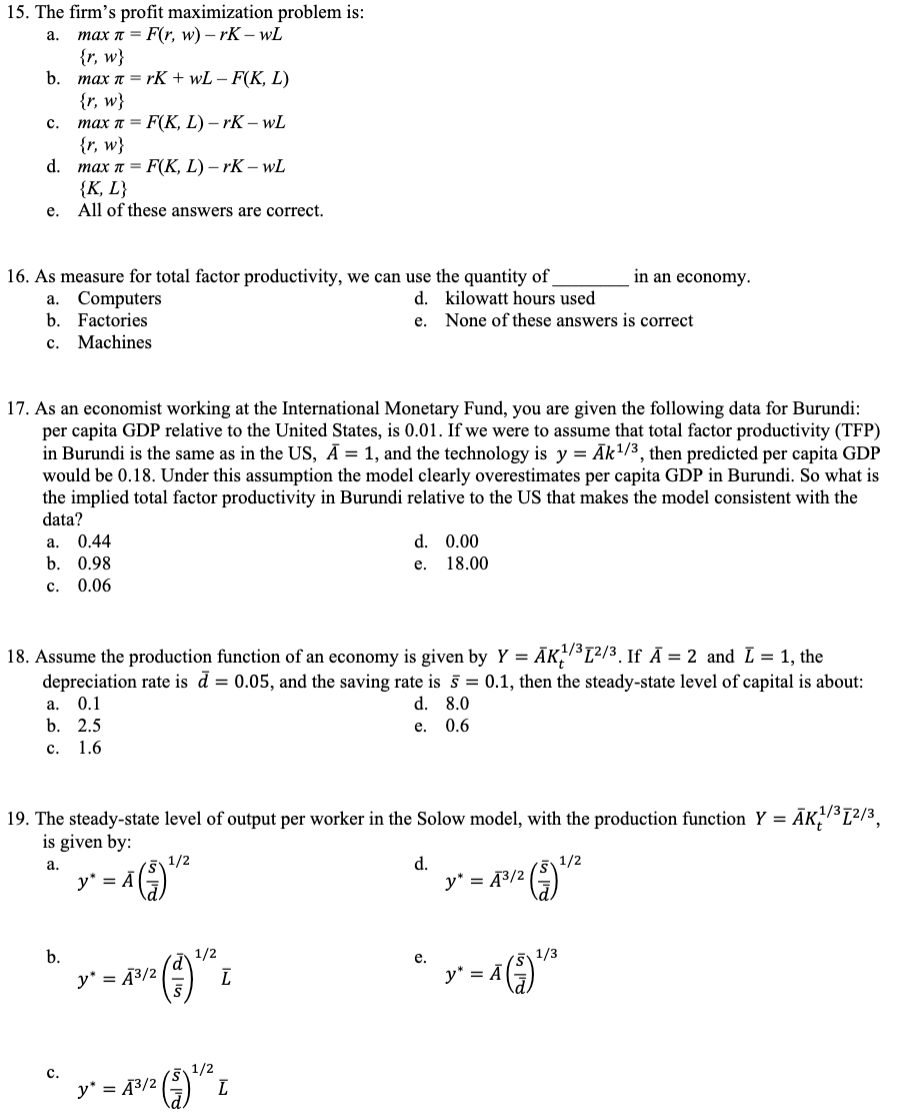15. The firm's profit maximization problem is: max n = F(r, w)-rk-wL {r, w} a. maxx=rK + wL-F(K, L) {r, w} max π = F(K, L)-rk-wL {r, w} b. C. max π = F(K, L)-rk-wL {K, L} e. All of these answers are correct. d. 16. As measure for total factor productivity, we can use the quantity of d. kilowatt hours used e. None of these answe a. Computers b. Factories
15. The firm's profit maximization problem is: max n = F(r, w)-rk-wL {r, w} a. maxx=rK + wL-F(K, L) {r, w} max π = F(K, L)-rk-wL {r, w} b. C. max π = F(K, L)-rk-wL {K, L} e. All of these answers are correct. d. 16. As measure for total factor productivity, we can use the quantity of d. kilowatt hours used e. None of these answe a. Computers b. Factories
Chapter11: The Firm: Production And Costs
Section: Chapter Questions
Problem 8P
Related questions
Question
Please help me answer 15-19

Transcribed Image Text:15. The firm's profit maximization problem is:
max π = F(r, w) -rk-wL
{r, w}
a.
b.
C.
d.
e.
in an economy.
16. As measure for total factor productivity, we can use the quantity of
kilowatt hours used
None of these answers is correct
d.
e.
max π = rK + wL - F(K, L)
{r, w}
max π = F(K, L)-rk-wL
{r, w}
max π = F(K, L)-rk-wL
{K, L}
All of these answers are correct.
a. Computers
b. Factories
C. Machines
17. As an economist working at the International Monetary Fund, you are given the following data for Burundi:
per capita GDP relative to the United States, is 0.01. If we were to assume that total factor productivity (TFP)
in Burundi is the same as in the US, A = 1, and the technology is y= Ak¹/3, then predicted per capita GDP
would be 0.18. Under this assumption the model clearly overestimates per capita GDP in Burundi. So what is
the implied total factor productivity in Burundi relative to the US that makes the model consistent with the
data?
a. 0.44
b. 0.98
C.
0.06
18. Assume the production function of an economy is given by Y = AK¹/³1²/³. If A = 2 and I = 1, the
depreciation rate is d = 0.05, and the saving rate is 5 = 0.1, then the steady-state level of capital is about:
0.1
a.
d. 8.0
b. 2.5
e. 0.6
C. 1.6
b.
19. The steady-state level of output per worker in the Solow model, with the production function Y =ĀK/³1²/3,
is given by:
a.
1/2
= ^ (1) ¹/²
C.
y*
d. 0.00
18.00
e.
1/2
y* = P³R (1) ¹² L
ó/2
ī
y* = 43/2 (3) ¹/2 t
d.
y² = A²/2 (2) ¹/²2
y"
e.
1/3
¹ y² = Ã (3) ¹²
Expert Solution
This question has been solved!
Explore an expertly crafted, step-by-step solution for a thorough understanding of key concepts.
Step by step
Solved in 2 steps

Knowledge Booster
Learn more about
Need a deep-dive on the concept behind this application? Look no further. Learn more about this topic, economics and related others by exploring similar questions and additional content below.Recommended textbooks for you

Exploring Economics
Economics
ISBN:
9781544336329
Author:
Robert L. Sexton
Publisher:
SAGE Publications, Inc

Essentials of Economics (MindTap Course List)
Economics
ISBN:
9781337091992
Author:
N. Gregory Mankiw
Publisher:
Cengage Learning


Exploring Economics
Economics
ISBN:
9781544336329
Author:
Robert L. Sexton
Publisher:
SAGE Publications, Inc

Essentials of Economics (MindTap Course List)
Economics
ISBN:
9781337091992
Author:
N. Gregory Mankiw
Publisher:
Cengage Learning


Principles of Economics, 7th Edition (MindTap Cou…
Economics
ISBN:
9781285165875
Author:
N. Gregory Mankiw
Publisher:
Cengage Learning

Principles of Microeconomics (MindTap Course List)
Economics
ISBN:
9781305971493
Author:
N. Gregory Mankiw
Publisher:
Cengage Learning

Principles of Economics (MindTap Course List)
Economics
ISBN:
9781305585126
Author:
N. Gregory Mankiw
Publisher:
Cengage Learning